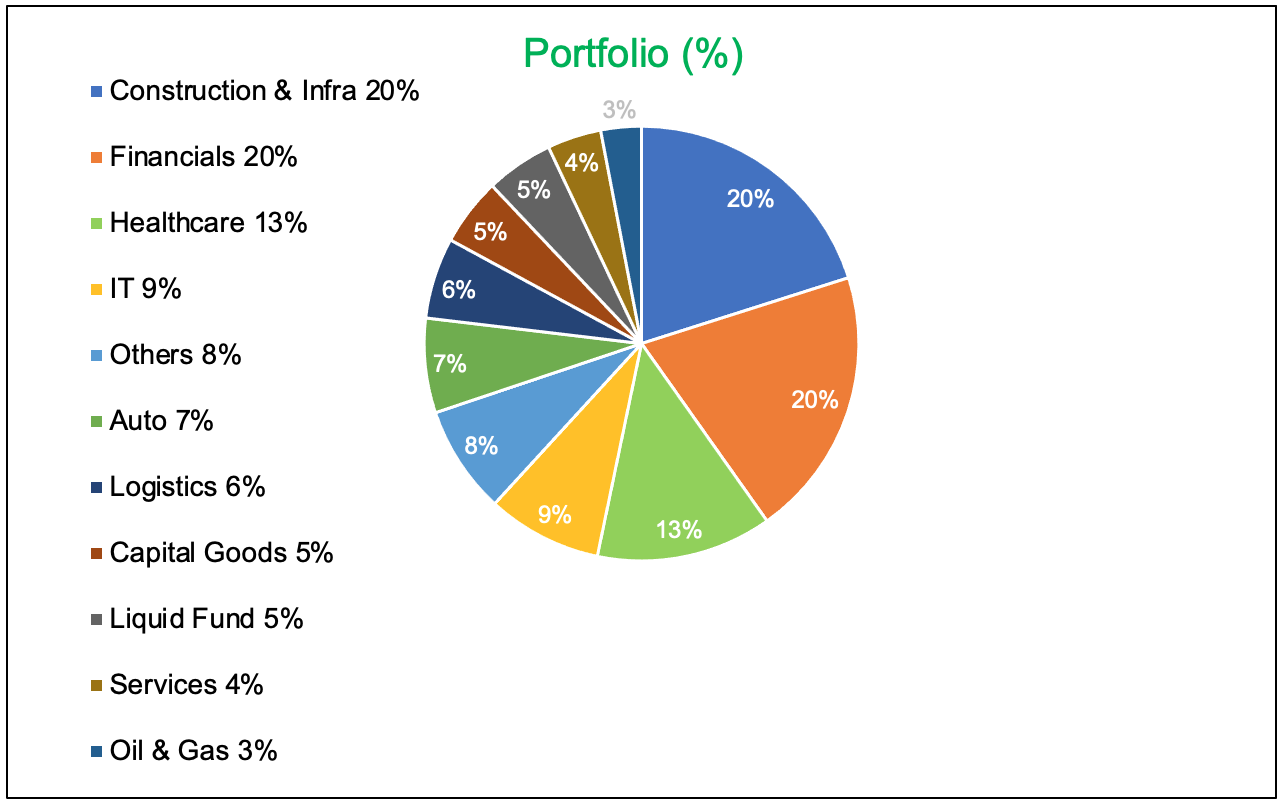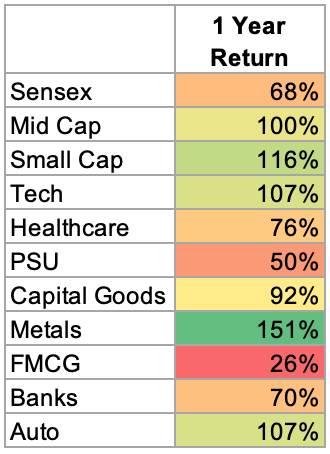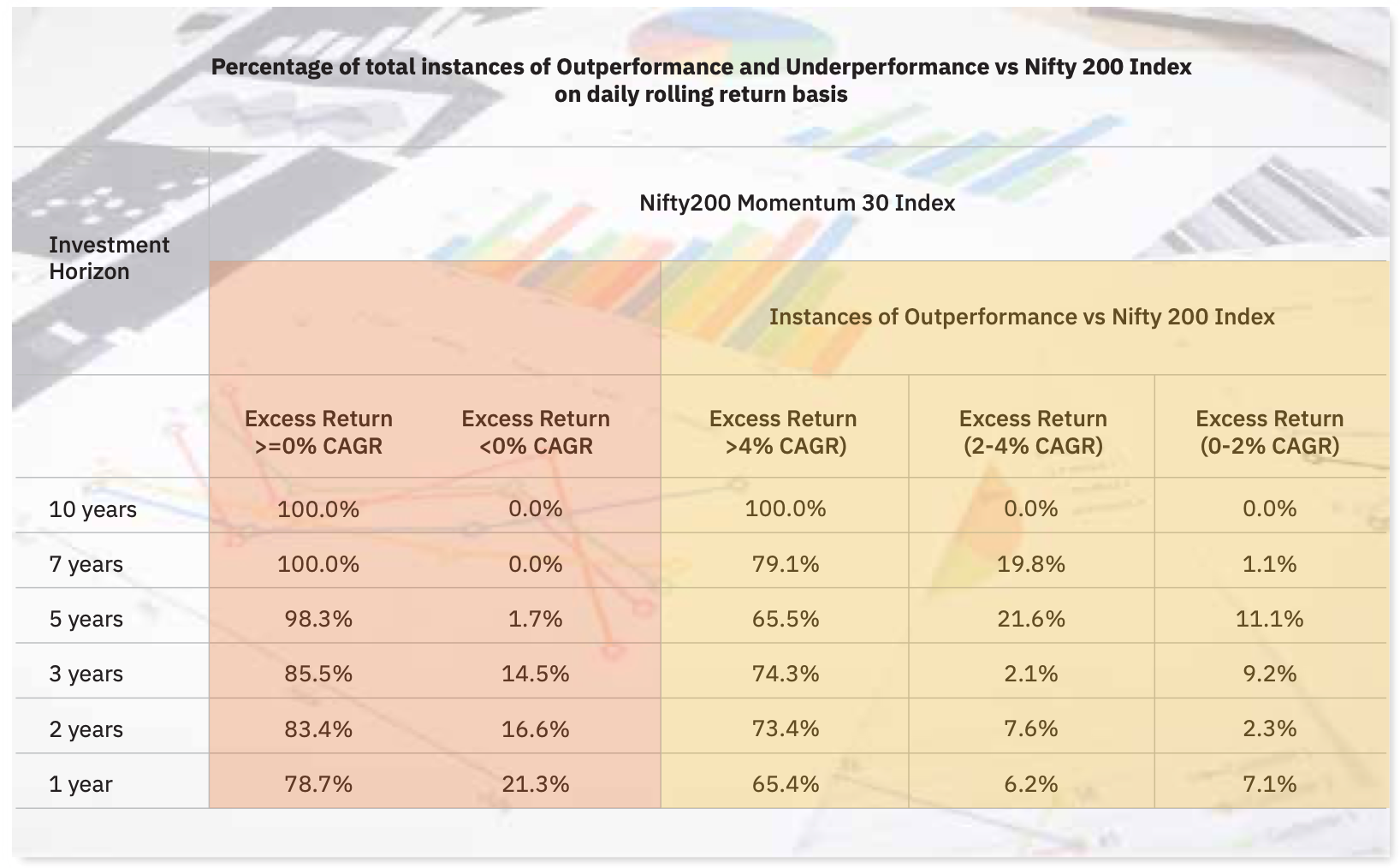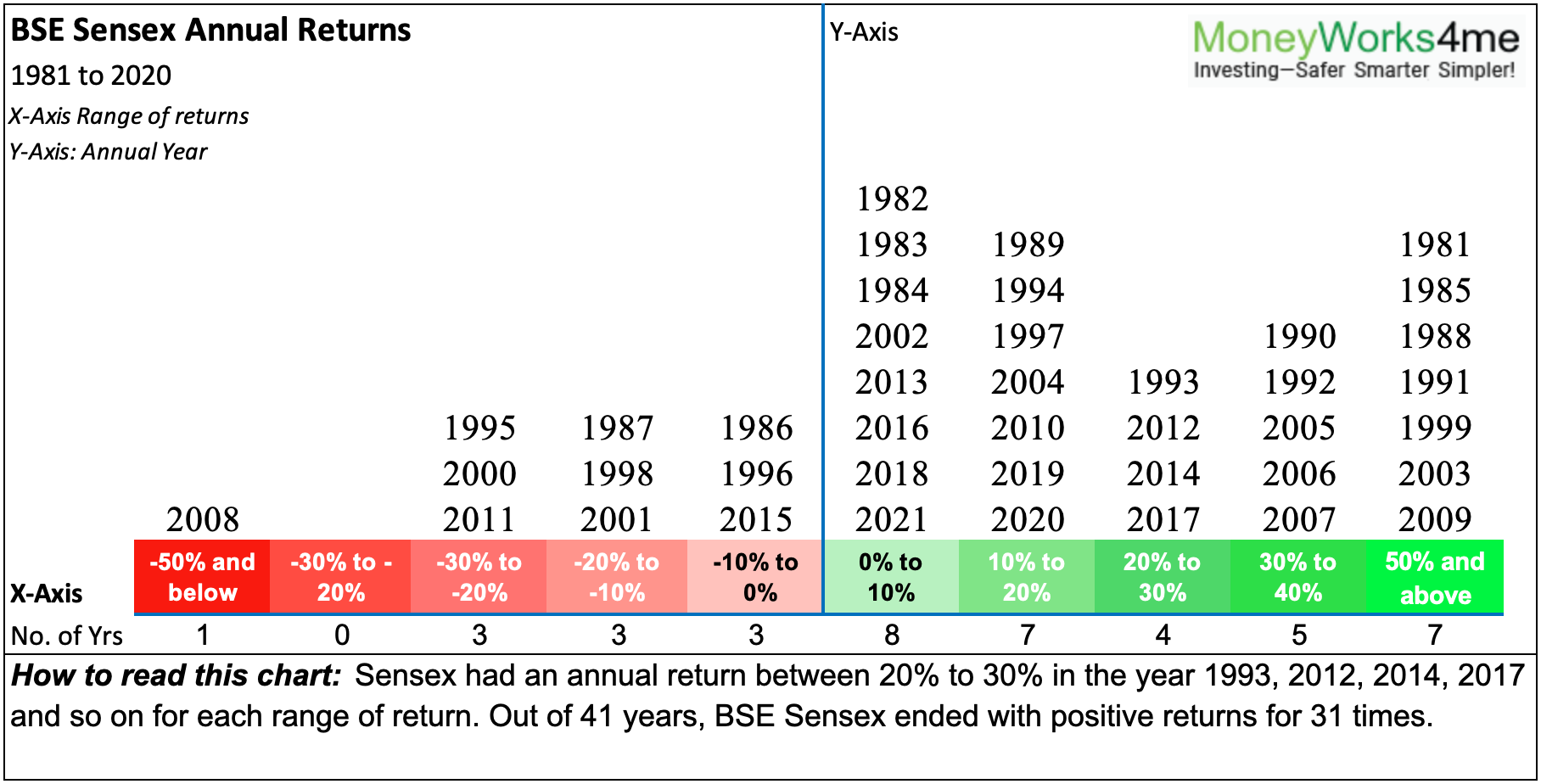This article covers the following:
Review
For the year ending Mar’21, Nifty closed at 14,691, around 71% higher than last year. In the last 3 years, Nifty is up 45% translating into ~13% CAGR.
Out of the total 71% return last 1 year, 23% of the returns came from three stocks HDFC Bank (7.6%), Infosys (7.4%), Reliance Ind (7.99%).
Low interest rates globally and optimism around vaccines have led to new highs for Nifty. The recent rally is led by cyclical stocks that were beaten down due to uncertainty about economic recovery.
Incremental macro data suggests an improvement in economic activity and better utilization. Pro expansionary Budget announced on Feb 1, 2021, further lead to a rally in the cyclical and infrastructure sector as they could benefit from the government’s focus on investments.
After a long time, the asset-heavy companies and cyclical stocks have better-expected growth rates on a low base, versus growth stocks. We are seeing sharp rallies in various cyclical. A lot of companies have new capacity coming online or utilization is increasing on a low basis.
Outlook
As of date, the average upside of our coverage universe is likely to be less than 10% CAGR over the next 3 years basis based on current estimates. The valuation of companies goes up every quarter if the company reports growth in earnings. This can improve the upside potential of stocks.
If we see growth improving next year, we may see an upward revision in our estimates. We have made upward revisions in sectors where we are seeing a sustained recovery in earnings and cash flows.
Nifty 50 index trades above its fair value while there are pockets of extreme overvaluation and undervaluation. Nifty – led by a concentrated portfolio of Top 10 stocks – is around 21% higher than its fair price, not true for all stocks. (Nifty@MRP 11,864)
MoneyWorks4me performance was strong last year as we got an opportunity to buy good companies at lower prices during the correction. Looking back, our process tends to deliver much higher than market returns coming out of the correction. From Apr’20 to Mar’21, the MoneyWorks4me portfolio was up 83% versus 71% for the Nifty 50 index.
More importantly, 3-year performance is 15% CAGR versus 13.5% CAGR for Nifty. Also it worth noting that, MoneyWorks4me portfolio did not have an excessive concentration in few stocks/single sectors versus Nifty’s concentration in stocks/sector (Top 5 stocks – 42%), (Top sector: Banks/Financials – 40%)
Today, we are looking at opportunities in infrastructure, building materials, export-oriented chemicals, PSUs, and import substitute ideas. We have incrementally added stocks in capital goods and Infrastructure as we started seeing sustained growth versus volatile growth earlier. We recently added two good quality companies in the logistics space.
We look at companies that have good earning triggers over the next 2 years as we are not certain whether broad-based recovery will happen immediately. We are investing in companies i) coming out of sector consolidation/debt reduction, or ii) introducing new products, or iii) commissioning new capacities, or iv) executing orders in hand. This gives certainty of growth rather than plain anticipation or, v) Export-oriented companies as economic recovery is better in western countries.
Investors have to ensure good companies at reasonable valuations. Currently, these factors are present in building materials, Pharma, IT, power & gas utilities, select capital goods, and infrastructure.
Good companies earn higher returns on capital than their cost of capital over a cycle, they are less cyclical and present in a growing sector. We recommend buying such stocks only at a reasonable price or at the start of the cycle. This will ensure one earns good risk-adjusted returns over a holding period of 3-5 years.
We recommend avoiding stocks/sectors that have run up much ahead of their earnings growth over the last 3-4 years. It might be late to scale up into stocks. These stocks may continue to do well in short term due to price momentum but the risks of lower return or losses are higher over a 3-year holding period.
Register FREE | Schedule a DEMO | Solution Enquiry | Themes | Subscribe
Risks
Indian Economy
GDP data saw two-quarters of year-on-year decline, while the recent quarter was more reasonable 7.5% versus the previous quarter decline of 23%. In a previous note, we had written that, fortunately, the cases have subsided and fear of the second wave is receding.
However, the cases are rising again in 5 states which are in line with the second wave observed elsewhere like the US and Europe. However, with vaccination already rolling out, the ability to contain the spread is much better versus the first wave. We believe as vaccination reaches 20-25% population in key vulnerable states/cities, the spread will be contained.
Auto sales are robust in pockets; however, vehicle registration has fallen for two consecutive quarters Jan’21 & Feb’21. Also, disruption in semiconductor shortage may affect Auto production numbers which don’t reflect any insight into economic recovery. We do not see much profit growth in Auto over the medium term due to the expected increase in investments to shore up electric vehicle production. Few companies may see profitability coming down due to new investments. Except for premium motorcycles and CV/Tractors, we have avoided auto stocks for now.
There is good demand for cement and steel and power. Electricity consumption has been consistently growing since Oct’20 indicating pick-up industrial activity. The cement sector is seeing good volume offtake from construction activity, especially in rural and semi-urban areas.
Rising oil prices are a risk as oil-producing countries are cutting supply leading to price rises. Fiscal Deficit in FY21 and FY22 is likely to be elevated versus long-term range which can lead to a sharp rise in bond yield affecting equity and bond prices.
Inflation from rising commodity and oil prices can spark fear in economic recovery. However, with lower utilization in various sectors, inflation might not be passed on completely to take advantage of higher volumes and favorable operating leverage.
Global Economy
Western countries are reporting better outlooks as vaccination is picking up pace. This can lead to economic recovery over the next 6 months. Large stimulus checks are handed over to citizens has led to cash flowing into bank accounts. As people get vaccinated, they will spend this on shopping and traveling. This will help in economic recovery.
Economic recovery means a positive sign. This is leading to falling in gold prices and bond prices as investors sell off their defensive positions. At the same time stretched balance sheet of the US government is causing investors to ask for higher yields, hence a fall in bond prices.
Offlate there are signs of speculative fervor in US markets and Cryptocurrencies. A lot of trading activity has led to an increase in leverage and higher trading volume. The rising interest rate will cause restrictions on speculative activity. There is a risk of synchronous global market correction at some point. US market has many late stages of cycle behavior versus Indian or European markets.
Frequently Asked Questions
Is it a good time to invest in Momentum Strategy?
In investing, the best strategy is often assumed to be the one that is performing well today. Recency bias makes us forget that there are many strategies that work in the market over the long term.
We believe that momentum strategy has its advantages but it also has higher volatility and higher downside versus other fundamental-based strategies. For investors, it’s important to know the pros and cons of each process and prefer what suits them the most. Every strategy works for many years and then it stops working for few years.
We see that NSE has introduced a Momentum index, Nifty 200 Momentum 30. Research paper on the same shows that the strategy underperforms the index just like any other strategy does from time to time.
Momentum 30 stocks will generate poor returns than Nifty 200 once every five years. Also, once in 7 years, there will be a three-year period when Momentum 30 will deliver lower than index return. This is true even for value, small-cap (size), and quality funds that lag the index temporarily.
According to our observation:
- Momentum –worked best in rising markets
- Value/Dividend – in flat or volatile markets
- Quality – in tough/bad economic conditions
- Size – in high growth and low inflation
In our Omega solution, we participate in each process as much as possible depending on valuation and outlook. It is difficult to anticipate every market cycle, so it’s prudent to be part of as many processes as possible.
We recommend investing only a portion of investable surplus in one strategy and giving it more than 5 years for improving chances of outperformance.
Shall we stay invested or sell equity?
Odds are highly in favor of staying invested rather than exiting or delaying fresh addition.
For fresh funds, we recommend 50-75% investment into stocks/funds that will do well over the next 5 years. If your time horizon is long term (5 years+), the current valuation will matter less. Here is one such exercise.
Nifty is indeed 20% expensive versus fair value. If Nifty is likely to earn 13% CAGR returns over the next 10 years, buying 20% above fair value reduces your returns by 2% CAGR i.e. it will earn 11% CAGR versus 13% CAGR. Now it doesn’t look so bad.
Now the risk is Nifty felt overvalued at 10,000 and 12,000 and again at 15,000. Those who jumped off earlier missed 50%+ returns from 10,000.
Is the market rally overdone, are we up for deep correction?
We think that compared to the US, Indian markets haven’t done much over the last 5 years to fear prolonged correction. India has been in downcycle for the last 5-8 years and it still has below-average corporate profits to GDP. This means that even if the Indian market will correct with global markets, all markets move together in short term, there are higher chances Indian markets will recover faster. Besides, Govt pro-business outlook has further put a floor to valuation.
Indian corporate sector is in the best position to gain pricing power and balance sheet strength. The majority of the sectors have seen consolidation. All inefficient and indebted firms are out of business while stronger ones now dominate the market.
We are seeing this across sectors: Power, Telecom, Cement, Banks, NBFCs, Real Estate, building materials, Paper, pharma, capital goods, consumer durables, etc. This will give strong profitability for incumbents due to the high barrier to entry for the next few years.
What sectors may do well over the next 3-5 years?
In long term (5 years+), or even medium-term (3 years), stock prices go up in lines with earnings growth and starting valuation. Even if there is volatility in the interim, the stock prices of good companies recover to match respective earning growth.
We believe that the current market has opportunities in the manufacturing and infrastructure/housing sector. Lower interest rate, pent-up demand, PLI scheme, rising commodity prices are very favorable for these sectors.

Every cycle has different sectors that perform well. We believe that favorable valuation and earning growth are two positives for manufacturing and infrastructure stocks.
We recommend equity investing only for long-term savings so that near-term events become irrelevant. We do not find any merit in second-guessing what’s going to happen in the next 6 months-1 year. If the shortlisted stocks are good companies, with good growth prospects, they will deliver returns in line with business performance. Picking the right stocks is easier than predicting the market direction.
We continue to recommend Gold Fund/Gold (up to 5-10% of the portfolio) as a hedge from contagion risks.
Avoid any type of regret while investing. Regret can come from either missing stock or not adding enough to a winning stock. Rather focus on overall strategy as explained above.
Do not disturb equity allocation in your asset allocation. At best you can increase/reduce 5-10%. Beyond this, tinkering with asset allocation will only reduce long-term returns or increase the risks of missing one’s target corpus.
We have diversified our stocks portfolio, we have diversified assets and we have a long-term horizon. Together this takes care of all potential risks in investing.
MoneyWorks4me Outlook:
MoneyWorks4me Solutions:
Need help on Investing? And more….Puchho Befikar
Kyunki yeh paise ka mamala hai
Why MoneyWorks4me | Why Register | Call: 020 6725 8333 | WhatsApp: 8055769463















